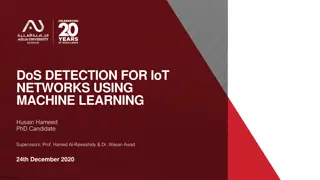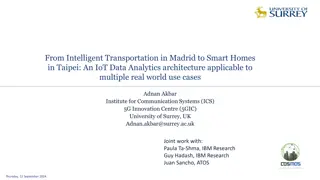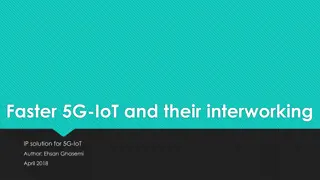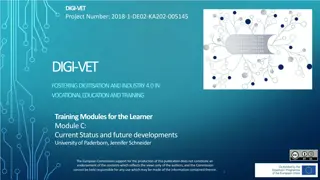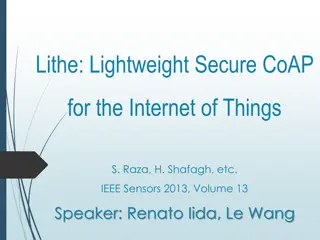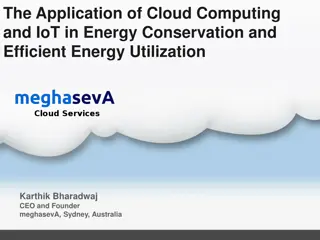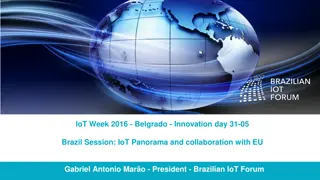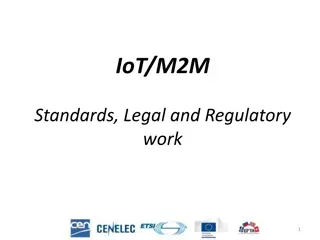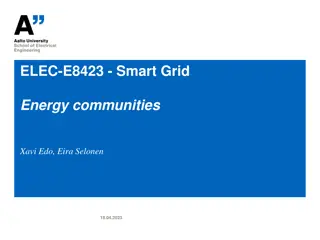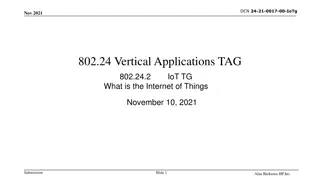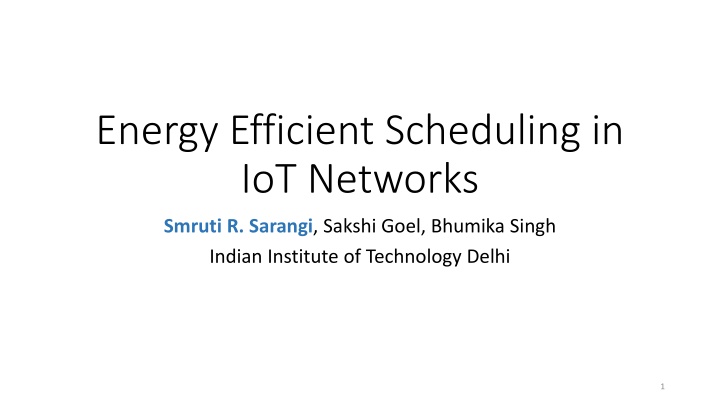
Energy-Efficient Scheduling in IoT Networks
This research delves into the challenges of energy efficiency in IoT networks, discussing current approaches, problems, and solutions to reduce energy consumption. It covers topics like IoT projections, energy dissipation, coordination mechanisms between nodes, and mobility-driven approaches for sensor networks.
Download Presentation

Please find below an Image/Link to download the presentation.
The content on the website is provided AS IS for your information and personal use only. It may not be sold, licensed, or shared on other websites without obtaining consent from the author. If you encounter any issues during the download, it is possible that the publisher has removed the file from their server.
You are allowed to download the files provided on this website for personal or commercial use, subject to the condition that they are used lawfully. All files are the property of their respective owners.
The content on the website is provided AS IS for your information and personal use only. It may not be sold, licensed, or shared on other websites without obtaining consent from the author.
E N D
Presentation Transcript
Energy Efficient Scheduling in IoT Networks Smruti R. Sarangi, Sakshi Goel, Bhumika Singh Indian Institute of Technology Delhi 1
Projections regarding IoT Networks Forbes Forecasts [1] 50-100 billion devices 450 billion $ market Smart cities, Industrial IoT, Connected health 2
Major Challenge in IoT Networks: Energy Efficiency Most IoT nodes run on batteries Many use intermittent sources of power Many applications need real time data analytics support 3
More about Energy Dissipation Communication Energy Processor Computation Energy We only focus on computation energy (up to 99% of energy consumption) Existing methods: DVFS, throttling, low power states 4
Problems with Current Approaches They make local choices The choice is independent of State of the environment Actions of other nodes Can we coordinate energy reduction mechanisms between IoT nodes? Will it lead to benefits? 5
Typical IoT Stack Region of Interest 6
Relevant Background A Activity factor P power C capacitance V voltage f frequency 2 P ACV f Reduce the activity Reduce the voltage and frequency (DVFS) Reduce both 7
Reducing Energy Consumption in Sensor Networks Mobility Driven Approaches Data Driven Approaches Duty Cycling Power the nodes off when they do not need to sense a signal or they do not need to transmit Move the motes closer to the source of the signal Change the sampling rate, data quantization, and eliminate redundancy 8
Model of the System From the sensors to the cloud From the cloud to the actuators Sensors Smart Gateways Cloud 9
Problem Statement Task Network Traffic (bytes) Worst case exec. cycles at each node Start time Deadline AIM: For a task minimize the energy without missing the deadline. Approach: At each node keep a dynamic estimate of the time required to finish the task Perform DVFS at each node accordingly Assume each node is a multicore processor, where we can set different frequencies per core 10
Algorithm for Applying DVFS at each Node freqmax maximum frequency trem max_time_to_execute_task() if (trem 0) run any core at freqmax; return if (there is an idle core) run on idle core with frequency = C/ trem else run on a core with min. frequency fi such that wi + ci/fi trem if no such core found increase frequency of core with maximum frequency to freqmax Periodically reduce the frequency of high frequency cores C Total exec. cycles wi average waiting time 11
Main Problem Gateways sensor actuator Task test We need to have a good estimate of test Then only we can compute trem = deadline current_time - test 12
Global Algorithm sensor Gateways actuator Central Server (CS) Each node computes a tavg average time between job arrival and departure It periodically sends it to the CS Separate tavg computed for each predecessor tavg Node Pred tavg for each predecessor CS
Global Algorithm - II The server computes test Sum of the tavg values for all the nodes in the chain till the actuator Plus the worst case network latency across all hops Enhancements Maintain a moving average of tavg values Use a distribution instead of a single value. 14
Local Algorithm Task test test Every node maintains a table of test values for its neighbors The test is piggybacked with every message Additionally, nodes often share this value with their neighbors (1 or 2 hop distance) Nodes add or subtract tavg, to update test depending on the direction They maintain a weighted moving average of test 15
Stability Properties Assume we initialize the system with the correct values of tavg and test It will remain stable If there are perturbations in the compute time or network delay They will get conveyed from the source of the perturbation to its neighbors. The information will gradually propagate Nodes near the actuator will always have accurate values. They will send this downstream 16
Evaluation 17
Simulation Setup Validated with NS3 and CloudSim IoT Simulator 1. 64 bit Ubuntu Linux System Intel Core i7 CPU, 3.10 Ghz, 4 GB RAM Sinaeepourfard et al. Data for Barcelona City Real World IoT Data 2. Energy values taken from the Tejas architectural simulator Configurations Gateway 0.5-1 GHz Deadline- Share No-DVFS Server 1.5-2 GHz DVFS Step 100 MHz 18
Deadlines Number of Sensors 16 32 64 128 256 512 1024 Tight Deadlines 3-4% 4-6% 7-10% 13-15% 22-26% 40-44% 72-78% Loose Deadlines 9-12% 14-18% 23-28% 40-45% 69-76% 80-90% 95-100% 19
Baseline: No-DVFS Energy Minimization with Tight Deadlines 1. Local does not scale 2. Mostly as good as global 20
Baseline: Deadline- Share Energy Minimization with Tight Deadlines Energy Minimization with Tight Deadlines 30-50% task drops for deadline- share 21
Baseline: Deadline- Share Energy Minimization with Loose Deadlines 30-50% task drops with Deadline-Share 22
Frequency of Sensing % Deadlines Violated Sensing Interval (s) 23
Conclusions Co-operative protocols can yield significant energy savings in IoT networks The global algorithm is the best in terms of scalability and task drop rates It is hard to implement The gossip based local algorithm performs very well for small and medium loads It has scalability issues. The search is on for a good hybrid approach .... 25
References 1. https://www.forbes.com/sites/louiscolumbus/2017/12/10/2017- roundup-of-internet-of-things-forecasts 26

